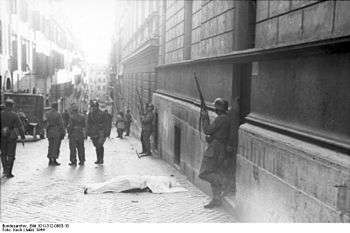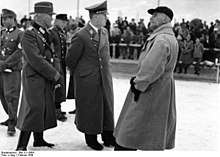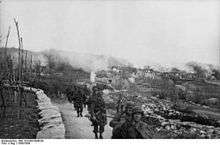SS Police Regiment Bozen
| SS Police Regiment Bozen | |
|---|---|
| SS-Polizeiregiment "Bozen" | |
 Members of Polizeiregiment "Bozen" in Rome following a partisan attack, 23 March 1944 | |
| Active | 1943–1945 |
| Country |
|
| Branch | Ordnungspolizei |
| Type | Police regiment |
| Role | Gendarmerie |
| Size | est. 2000 (Fall 1943) |
| Garrison/HQ | Gries-San Quirino, the Palazzo del Viminale |
| March | Hupf, mein Mädel (unofficial)[1] |
The SS Police Regiment Bozen, known in German as the Polizeiregiment Südtirol from 1 October to 29 October 1943 and SS-Polizeiregiment Bozen from 16 April 1944,[2] was a police formation of the Ordnungspolizei that operated in the South Tyrol during the German occupation. Its soldiers were conscripted locally while its commissioned officers came from Germany. The three battalion-strong unit is most infamous for its participation in the Ardeatine massacre after 35 soldiers were killed by partisans in Rome on 23 March 1944.[lower-alpha 1] The unit has also been central to the controversy surrounding the Via Rasella attack.
The regiment's first and second battalions were active in Istria and Belluno respectively, while the third battalion was a reserve unit stationed in Rome. All three surrendered to Allied or partisan forces in the last days of the war.
Background

Following the Badoglio Proclamation on 8 September 1943, the announcement of the Armistice of Cassibile, Germany launched an invasion of Italy. Two days later, South Tyrol, Trentino and Belluno came under German control as the Operational Zone of the Alpine Foothills (Operationszone Alpenvorland, OZAV). This region formally existed under the Italian Social Republic, but was de facto ruled by Franz Hofer, the Gauleiter of Tyrol-Vorarlberg.[5]
The Central Recruitment Office was set up in South Tyrol by the Wehrmacht and Waffen-SS to form military units from residents of the OZAV. German authorities were at first limited to "Optanten," Tyroleans who had opted for German citizenship,[6] but poor recruit prompted Hofer to begin conscription in the region on 30 November 1943.[7] All men born in 1924 and 1925 were drafted into the Todt Organization, Südtiroler Ordnungsdienst (SOD), Trento Security Corps (CST), Ordnungspolizei, or into the Wehrmacht or Waffen-SS.[6] A following ordinance on 7 January 1944 widened the draft pool to all men born between 1894 and 1926, regardless of nationality. Dableiber, Tyroleans who had opted for Italian citizenship, were accused of treason and harassed. Many were sent to the Eastern Front. Draft evasion incurred a death sentence and persecution of relatives, according to the Nazi doctrine of Sippenhaft.[8]
The forced recruit of the Dableiber and the harsh punishment dolled out against draft evaders, as was the case for Franz Thaler, violated Articles 44, 45, and 46 of the Hague Convention of 1899. Germany was a signatory to the 1889 convention.[9]
Service history
Polizeiregiment "Südtirol" was formed in October 1943 under the command of Oberst Alois Menschick. By the end of the month the regiment, now called Polizeiregiment "Bozen",[lower-alpha 2] had over 2000 soldiers in four battalions, each composed of four, later three, numbered battalions (I, II, III). Its members were trained for three months in the use of their weapons (mostly of Italian make), camouflage, squad combat, and counter-guerrilla warfare.[6] They were sworn into the Wehrmacht on 30 January in the presence of Karl Wolff and Karl Tinzl,[11] then were assigned to the front.[12]
First battalion
I Battalion, composed of 900 men under the command of Major Oskar Kretschmer,[13] was sent to Istria, then in the Operational Zone of the Adriatic Littoral (Operationszone Adriatisches Küstenland, OZAK), in February 1944.[14] Based out of the Opatija and under the direct command of the Ordnungspolizei commander in Trieste, Oberstleutnant Hermann Kintrup and indirectly commanded by the commander of the Waffen-SS in OZAK, Odilo Globočnik, was tasked with combating partisans and securing transportation from Trieste to Ljubljana. I Battalion was the only fully motorized battalion in the regiment,[13] possessing an AB 41 and a Lancia 1ZM, both armored cars, and a single L3/33 and L3/35 tankette, all captured from the Italians after 8 September 1943.[15]
On 5 April 1944, I Battalion embarked on Operation Bozen in the area of Brnčići, near Kastav, resulting in the razing of the village of Gornji Turki. The battalion then participated in Operation Braunschweig.[16] On 30 April, German troops of the 278th Infantry and 188th Reserve Mountain Divisions,[17] and the 24th Waffen-SS Karstjäger,[18] razed the village of Lipa and killed its 263 inhabitants.[17] Croatian researcher Petra Predoević found that some testimonies and archival data implicated the Bozen Regiment, whose attack by Yugoslav partisans have been the cause of the Lipa massacre.[18] On 3 May, the 3rd Company was assigned to Cacitti (between Divača and Hrpelje-Kozina), while the 2nd Company was deployed to Šušnjevica as a Sicherungsgruppe (security group) to cut off partisan withdrawal from the area.[19]
As Axis forces withdrew from the Balkans, I Battalion was stationed at Ajdovščina, then to Tolmin.[20] Finally, in an attempt to impede the British 8th Army, the battalion was sent to the Predil Pass, near the modern Italian-Slovene border. The battalion surrendered to the 8th Army at Thörl-Maglern, Carinthia in May 1945 after a lengthy retreat.[2] Under Allied custody, the battalion was sent to a camp at Kötschach-Mauthen, from which some of its members escaped by to the South Tyrol through the Gailtal. The prisoners were first transferred to Udine, then to Bellaria – Igea Marina and were guarded with greater attention by New Zealander and Polish soldiers. The escapees from Kötschach-Mauthen and made it home were required to appear at the "Vittorio-Veneto" barracks in Bolzano, arrested, put under surveillance, and transferred to Rimini and then to Taranto. All prisoners were released in September 1946.[6]
Second battalion
II Battalion was sent to Belluno Province in February 1944 where, between March and December, it made 85 anti-partisan actions. The most prominent of these were in the Biois valley in August and the Monte Grappa in September. From 20 August and into 21 August, contingents of II Battalion under Zugwachtmeister Erwin Fritz,[21] 1st Fallschirm-Panzer Hermann Göring, and the SS-Gebirgs-Kampfschule at Predrazzo were involved in the Biois valley massacre.[22] As a result of their actions, 44 civilians were killed and another 645 made homeless by the destruction of 245 homes.[23] In March 1945, II Battalion hung 14 civilians in Belluno's central square for the killing of thee soldiers by partisans. South Tyrolean historian Leopold Steurer noted that the battalion, and the Bozen Regiment by extension, became infamous for its brutality in Belluno.[24]
Most of II Battalion was taken prisoner by partisans at Agordo on 2 May 1945. Battalion members who had attempted escape through the Agordino were re-apprehended and held a camp at Cencenighe Agordino, were participants in the Biois valley massacre were shot on recognition. The remaining prisoners were handed over to the Americans and joined I Battalion at Rimini. Like I Battalion, II Battalion was released from prison in September 1946.[25]
Participants of the Biois valley massacre were tried in 1979, but acquitted on lack of evidence. When called to testify, they condemned the behavior of their former commanders.[26] Erwin Fritz, then a resident of Göttingen, West Germany and a retired police commissioner, was tried in absentia because his extradition was refused. Fritz's defense was given to Roland Riz, the vice-president of the South Tyrolean People's Party, who requested an acquittal.[27] Fritz was initially sentenced with life imprisonment by the Corte d'Assise of Bologna, which was rescinded by an appeal that found the sentence impotent by lack of jurisdiction. Fritz was again tried in 1988, by the Military Tribunal of Verona, but acquitted based on lack of evidence.[28]
Chain of command
- Regimental Commander: Oberst der Schutzpolizei Alois Menschik
- Regimental Adjutant: Hauptmann der Schutzpolizei Ullbrich
Battalion Commands
- 1st Battalion:
- Companies 1 - 5
- 2nd Battalion: Major der Schutzpolizei Schroder
- Companies 6 - 10
- 3rd Battalion: Major der Schutzpolizei Hellmuth Dobbrick
- Companies 11 - 13
Senior order of battle
- Supreme SS and Police Command (Italien) - SS-Obergruppenführer Karl Wolff
- SS and Police Command (Mitteitalien-Verona) - SS-Brigadeführer Wilhelm Harster
- 15th SS Police Regiment (Regular SS Garrison in Rome) - Oberstleutnant der Schutzpolizei Ludwig Buch
- SS Police Regiment "Bozen" (Ethnic SS Regiment)
- SS Police Regiment "Brixen" (Ethnic SS Regiment)
- 15th SS Police Regiment (Regular SS Garrison in Rome) - Oberstleutnant der Schutzpolizei Ludwig Buch
- SS and Police Command (Mitteitalien-Verona) - SS-Brigadeführer Wilhelm Harster
The overall military command which encompassed the corresponding SS units was the German 14th Army under the command of Generaloberst Eberhard von Mackensen. The SS garrison troops in Rome were under the command of the German occupation commander Luftwaffe General Kurt Mälzer. Both men answered to Field Marshal Albert Kesselring, considered the highest-ranking German commander in the Italian theatre.
Notes
- ↑ There is dispute on the exact number of casualties from the Via Rasella before the Ardeatine massacre. Rosario Bentivegna says that there were 32 fatalities and 56 injuries of Polizeiregiment Bozen.[3] The newspaper of the German 14th Army reported 32 deaths and 54 injuries.[4]
- ↑ There is debate on when Polizeiregiment "Südtirol" changed its name. Michael Wedekind gives 29 October 1943,[2] while other sources claim the change took place in November.[10]
Citations
- ↑ Katz 2009, p. 241.
- 1 2 3 Wedekind 2003, p. 329.
- ↑ Bentivegna 2004, p. 364.
- ↑ Steinacher 2012, p. 293.
- ↑ Bentivegna 2004, pp. 353–56.
- 1 2 3 4 Marzilli, Marco. "Il Polizeiregiment "Bozen"" (in Italian). Retrieved 15 June 2015.
- ↑ Baratter 2005, p. 187.
- ↑ Baratter 2005, pp. 187–89.
- ↑ Baratter 2005, p. 342.
- ↑ Baratter 2005, p. 186.
- ↑ "Feierliche Vereidigung des Polizeiregimentes Bozen". Bozner Tagblatt (in German). 31 January 1943. Retrieved 25 September 2018.
- ↑ Wedekind 2003, pp. 328–29.
- 1 2 Di Giusto 2005, p. 320.
- ↑ "Deutsches Historisches Institut in Rom" (in German). Archived from the original on 14 December 2014. Retrieved 14 December 2014.
- ↑ Baratter 2005, p. 197.
- ↑ Di Giusto 2005, p. 394, 396.
- 1 2 Klanjšček 1984, p. 266.
- 1 2 Predoević 2007, p. 11.
- ↑ Di Giusto 2005, p. 396.
- ↑ Di Giusto 2005, pp. 597, 604.
- ↑ Bentivegna 2004, p. 360.
- ↑ La Stampa, 16 February 1978.
- ↑ Wedekind 2003, p. 330.
- ↑ Südtirol Profil, 14 March 1994.
- ↑ Wedekind 2003, pp. 329–30.
- ↑ Baratter 2005, p. 184.
- ↑ La Stampa, 10 July 1979.
- ↑ Corriere delle Alpi, 18 August 2007.
References
Secondary sources
- Andrae, Friedrich (1997). La Wehrmacht in Italia. La guerra delle forze armate tedesche contro la popolazione civile 1943-1945 (in Italian). Editori Riuniti. ISBN 88-359-4233-0.
- Baratter, Lorenzo (2003). Dall'Alpenvorland a Via Rasella. Storia dei reggimenti di polizia sudtirolesi (1943-1945) (in Italian). Publilux.
- Baratter, Lorenzo (2005). Le Dolomiti del Terzo Reich (in Italian). Mursia. ISBN 88-425-3463-3.
- Bentivegna, Rosario (2006). Via Rasella. La storia mistificata. Carteggio con Bruno Vespa (in Italian). Manifesto Libri. ISBN 88-7285-447-4.
- Benzoni, Alberto; Benzoni, Elisa (1999). Attentato e rappresaglia. Il PCI e via Rasella (in Italian). Marsilio. ISBN 88-317-7169-8.
- Di Giusto, Stefano (2005). Operationszone Adriatisches Künstenland. Udine, Gorizia, Trieste, Pola, Fiume e Lubiana durante l'occupazione tedesca 1943-1945 (in Italian). Istituto friulano per la storia del movimento di liberazione.
- Fry, Helen (2017). The London Cage: The Secret History of Britain's World War II Interrogation. Yale University Press. ISBN 9780300221930.
- Katz, Robert (1968) [1967]. Death in Rome. Pyramid Books. ASIN B0007ET5HI.
- Katz, Robert (2009) [2003]. Roma città aperta. Settembre 1943 - Giugno 1944 (in Italian). Il Saggiatore. ISBN 88-565-0047-7.
- Klanjšček, Zdravko (1984). Narodnooslobodilački Rat u Sloveniji 1941-1945 (in Croatian). Vojnoistorijski institut.
- Klinkhammer, Lutz (1997). Stragi naziste in Italia. La guerra contro i civili (1943-44) (in Italian). Donzelli Editore. ISBN 88-7989-339-4.
- Lepre, Aurelio (1996). Via Rasella. Leggenda e realtà della Resistenza a Roma (in Italian). Editori Laterza. ISBN 88-420-5026-1.
- Portelli, Alessandro (2012) [1999]. L'ordine è già stato eseguito. Roma, le Fosse Ardeatine, la memoria (in Italian). Feltrinelli. ISBN 978-88-07-723421.
- Prauser, Steffan (April 2002). "Mord in Rom? Der Anschlag in der Via Rasella und die deutsche Vergeltung in den Fosse Ardeatine im März 1944" (PDF). Vierteljahrshefte für Zeitgeschichte (in German). 50 (2). ISSN 0042-5702.
- Predoević, Petra (2007). "Operacija Braunschweig". Klepsidra (in Croatian). University of Rijeka.
- Raiber, Richard (2008) [2001]. Anatomy of Perjury. Field Marshal Albert Kesselring, Via Rasella, and the GINNY Mission. University of Delaware Press. ISBN 978-0-87413-994-5.
- Staron, Joachim (2007) [2002]. Fosse Ardeatine e Marzabotto. Storia e memoria di due stragi tedesche (in Italian). Il Mulino. ISBN 88-15-11518-8.
- Steinacher, Gerald (2012). "Das Massaker der Fosse Ardeatine und die Täterverfolgung. Deutsch-italienische Störfalle von Kappler bis Priebke". Faculty Publications, Department of History, University of Nebraska-Lincoln (in German). Böhlau Verlag. ISBN 978-3-205-78545-3.
- Vespa, Bruno (2008). Vincitori e vinti. Le stagioni dell'odio. Dalle leggi razziali a Prodi e Berlusconi (in Italian). Mondadori. ISBN 88-04-57469-0.
- Wedekind, Michael (2003). Nationalsozialistische Besatzungs- und Annexionspolitik in Norditalien 1943 bis 1945. Die Operationszonen "Alpenvorland" und "Adriatisches Küstenland" (in German). Oldenbourg Verlag. ISBN 3-486-56650-4.
- Zanette, Michele (2011). "L'Alto Adige di Hitler. Collaborazione e resistenza durante l'occupazione nazista dell'Alto Adige 1943 - 1945". Anno Accademico (in Italian). University of Trento.
News sources
- Gandini, Umberto (1979). "Quelli di via Rasella. La storia dei sudtirolesi che subirono l'attentato del 23 marzo 1944 a Roma". Alto Adige (in Italian).
- Franceschini, Christoph (14 March 1994). "Das Trauma von Rom". Südtirol Profil (in German).
- Tessandori, Vicenzo (16 February 1978). "La strage dei nazisti a Falcade nel Bellunese". La Stampa (in Italian). Retrieved 14 October 2018.
- "Criticata a Bolzano condanna a duo nazisti". La Stampa (in Italian). 10 July 1979. Retrieved 14 October 2018.
- "Caviola, 63 anni fa la strage". Corriere delle Alpi. 18 August 2007. Retrieved 14 October 2018.
Memoires
- Amendola, Giorgio (1973). Lettere a Milano. Ricordi e documenti 1939-1945 (in Italian). Editori Riuniti.
- Bentivegna, Rosario (2004) [1983]. Achtung Banditen! Prima e dopo via Rasella (in Italian). Mursia. ISBN 88-425-3218-5.
- Calamandrei, Franco (1984). La vita indivisibile. Diario 1941-1947 (in Italian). Editori Riuniti.
- Capponi, Carla (2009) [2000]. Con cuore di donna. Il Ventennio, la Resistenza a Roma, via Rasella: i ricordi di una protagonista (in Italian). Il Saggiatore. ISBN 88-565-0124-4.
- Trabucco, Carlo (1945). La prigionia di Roma. Diario dei 268 giorni dell'occupazione tedesca (in Italian). Editrice S.E.L.I.
External links
- Entry on the Atlas of Nazi and Fascist Massacres website (in Italian)
- Regimental History (in Italian)
- Südtiroler Archiv - Bildarchiv Urban Rienzner (in Italian)
